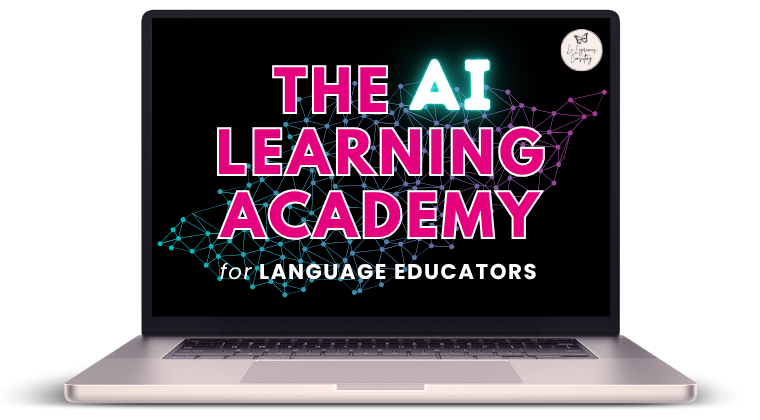If you are a language teacher, then you are probably using comprehensible input teaching methods (repeat, recycle, repeat) or have heard about them – it is not a surprise that by adjusting language strategically and providing input (either spoken or written) that is tiered to only include words, phrases and structures that students comprehend – students will be able to make meaning of the language and in fact, acquire. Which is how and why Acquisition Driven Instruction works so well. Our goal as language educators is to fill our student’s minds with lots of useful language, so they can USE the language in the future in their presentational and interpersonal communication. This is also why I believe WE (the people who use languages) keep the languages alive- and languages do in fact change and evolve over time, thanks to all of us!
As Generative AI begins to take over how we “do” our day to day tasks – let me attend that meeting but have my AI assistant take notes, let me figure out what is for dinner tonight or let me write that important letter of recommendation – it also makes sense to look at how this incredible technology can assist language teachers with designing resources and activities with comprehensible input at the heart of the design. And, in addition to a CI lens, can we also harness the power of Generative AI to focus on true intercultural aspects of the target language (products, perspectives & practices) AND design lessons that meet ALL of our student’s needs? My friends – the answer is YES!
Let’s begin with THE PROMPT! The most important part of using any Generative AI tool is how descriptive you are with writing your prompt. Chat GPT is continuing to learn YOU and understand who you ARE – and as a result, you must specify with your language, level, proficiency target(s), students (general information*), content, delivery of content and potential modifications in mind.
I’ve designed the below guide to assist language teachers create a well designed prompt, with the intentionality of having the “export” align with your expectations. I’ve also created a collaborative prompt library for language educators, which is one of the many perks in joining the AI Learning Academy for Language Educators community. When designing your prompt, consider all of the different important elements that you would like to include. A simple rule of thumb is understanding the better the prompt provided, the better the output. Chat GPT or other LLMs of preference can truly serve as your thought partner, brainstorming buddy, content creator or my favorite role- your new personal assistant. Consider the possibilities!
So, how do we merge the world of AI with CI? It all goes back to your well designed prompt! By specifying the type of language instruction model you are using, reference using cognates in your language (hopefully they exist!), frequently used words from the target language and specific targeted vocabulary (not sheltering grammar & treating expressions as vocabulary words) – the content created by Generative AI will align to your ADI expectations. Not convinced, plug the following prompt into your LLM and see what it can do!
You are an acquisition driven instruction teacher of Spanish, which means you focus on delivering comprehensible input and making language easy to understand and comprehend for beginning language learners. You teach a group of 7th grade students in a suburban middle school and they are currently discussing their school schedules and day to day activities using Novice Mid or A1 language. Can you write a paragraph (no more than 150 words each) in Spanish in comparing and contrasting a typical school day in Spain with a typical school day in the United States. Include information about schedules, subjects, and extracurricular activities. Repeat and reuse the following vocabulary expressions at least three times in this paragraph: tiene, empieza, termina, es aburrido, es interesante. In addition to cognates and the vocabulary provided, use ONLY the most frequently used vocabulary in the Spanish language. You can reference this website for the top 100 frequently used words in Spanish to assist you with your development of this reading passage: https://spanishforyourjob.com/commonwords/, use cognates frequently. For this paragraph, create at least five follow up comprehension questions based on this paragraph in Spanish and one open-ended prompt for beginning level language learners to respond. Create a simple table with a typical school schedule with start/end times using military time and specific classes at each time in both countries, in Spanish. And design a simple dialogue between a teenager from Spain and a teenager from U.S.A. discussing the key information from the paragraph about their school days.
I used Gemini (Google’s LLM) and it provided the following Google Doc ( *asked if I could export the schedule/table into a Google spreadsheet as well). The fascinating part is that designing this initial resource for me took a matter of seconds. And of course, I can look at this “School Life” reading as an initial draft and go in to make modifications to further customize it, understanding that my students should comprehend at least 90% of this reading. I can also have the LLM create “tiered” versions of this text, further simplifying it or making it a bit more challenging, to allow for students to read the text at their individual reading level. And – to take this reading passage and use an AI tool to design a slideshow export – head over to Diffit.me and copy/paste your text into the third section labeled “Any text or excerpt” and let the magic happen! Diffit.me can also export into Google Docs, Google Forms, pptx or PDF files.
Another great way to merge the world of AI with CI is with chatbot design and providing a low-stakes environment for interpersonal practice! I had previously blogged about using chatbots in the language classroom as conversational partners. Remember, your chatbot can be ANYONE! So who would you like your students to chat with? Someone famous? An artist? A musician? An athlete? And the same goes with WHAT your students are chatting about with their chatbots – you can ask your chatbot to target specific vocabulary and adhere to the provided conversational rules. Similarly to those reading passages, you have to set the specific parameters with language use and level to ensure that the chatbot adheres to your expectations and truly becomes a great language practice partner for your students!
One more tip considering how a CI-focused teacher can leverage the power of AI tools – Generative AI can also design images, change backgrounds and create videos for you! So, if you have a fun story that you were never really able to locate the right pictures to match the storyline – check out Canva, Magic Design and see what image(s) or video can be generated for you. Here are some neat images that I generated this afternoon while working with a fantastic group of language teachers!
Canva also now has Dall-E (OpenAI’s Image Generator) and as teachers, we receive premium access to this incredible platform. Canva has so many neat capabilities, I continue to enjoy exploring and experimenting- check out their “AI-powered” apps!
Looking to dive in deeper? Here is where I would love to continue to help support your journey as a language teacher! I have set up a annual subscription-based learning community for language educators; The AI Learning Academy for Language Educators (with monthly meetings, access to five courses, quarterly newsletter with insights), host free-virtual meetings often for the Team Lo Logramos FB community, and designed a variety of courses (one with Joe Dale). We accept School POs!
I hope this post has given you some great ideas on how to leverage Generative AI with a CI focus in the future!








Trackbacks/Pingbacks